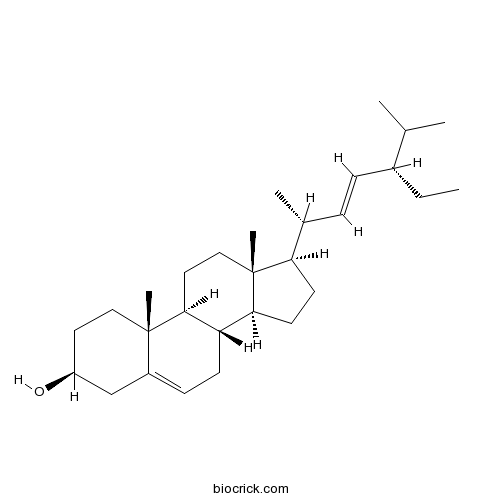Kochia scoparia
Kochia scoparia
1. The products in our compound library are selected from thousands of unique natural products; 2. It has the characteristics of diverse structure, diverse sources and wide coverage of activities; 3. Provide information on the activity of products from major journals, patents and research reports around the world, providing theoretical direction and research basis for further research and screening; 4. Free combination according to the type, source, target and disease of natural product; 5. The compound powder is placed in a covered tube and then discharged into a 10 x 10 cryostat; 6. Transport in ice pack or dry ice pack. Please store it at -20 °C as soon as possible after receiving the product, and use it as soon as possible after opening.
Natural products/compounds from Kochia scoparia
- Cat.No. Product Name CAS Number COA
-
BCN5616
Oleanolic acid508-02-1
Instructions

-
BCN1019
Tectorigenin548-77-6
Instructions

-
BCN4376
Stigmasterol83-48-7
Instructions

-
BCN1216
Momordin Ic96990-18-0
Instructions

The interactions of metal concentrations and soil properties on toxic metal accumulation of native plants in vanadium mining area.[Pubmed: 29857314]
High demand of Vanadium (V) in high-strength steel and battery manufacturing industry led to extensive V mining activity in China, and caused multi-metal pollution of soil around V mining area. To understand the phytoremediation potentials of native plants grown in V mining area, and the effect of soil properties and soil metal concentrations on toxic metal accumulations of native plants. Setaria viridis, Kochia scoparia and Chenopodium album were sampled from different sites in V mining area, soil properties, soil metal concentrations and metal accumulation amount of investigated plants were measured, bioaccumulation (BAF) and translocation (TF) efficiencies were calculated. Soil pH, cation exchange capacity (CEC) and available phosphorous (P) can significantly affect V and copper (Cu) uptake in the shoots of Setaria viridis while soil metal contents were lower than the permissible limits. Soil pH can significantly affect V accumulations in the roots and shoots of Kochia scoparia grown in slightly V polluted soils. Setaria viridis exhibited TF > 1 for moderately V and slightly chromium (Cr) polluted soils, and BAF>1 for slightly Cu contaminated soils respectively. Kochia scoparia and Chenopodium album showed TF > 1 and BAF>1 for slightly V polluted soils, respectively. Setaria viridis was practical for in situ phytoextractions of moderately V and slightly Cr polluted soils, and phytostabilization of slightly Cu contaminated soils. Kochia scoparia and Chenopodium album could be used as phytoextractor and phytostablizer in slightly V polluted soils in V mining area. Metal uptake of native plants grown in slightly multi-metal contaminated sites in V mining area can be manipulated by altering soil properties.
Reduced Translocation of Glyphosate and Dicamba in Combination Contributes to Poor Control of Kochia scoparia: Evidence of Herbicide Antagonism.[Pubmed: 29593313]
Kochia scoparia is a troublesome weed across the Great Plains of North America. Glyphosate and dicamba have been used for decades to control K. scoparia. Due to extensive selection, glyphosate- and dicamba-resistant (GDR) K. scoparia have evolved in the USA. Herbicide mixtures are routinely used to improve weed control. Herbicide interactions if result in an antagonistic effect can significantly affect the management of weeds, such as K. scoparia. To uncover the interaction of glyphosate and dicamba when applied in combination in K. scoparia management the efficacies of different doses of glyphosate plus dicamba were evaluated under greenhouse and field conditions using GDR and a known glyphosate- and dicamba-susceptible (GDS) K. scoparia. The results of greenhouse and field studies suggest that the combination of glyphosate and dicamba application controlled GDS, but glyphosate alone provided a better control of GDR K. scoparia compared to glyphosate plus dicamba combinations. Furthermore, investigation of the basis of this response suggested glyphosate and dicamba interact antagonistically and consequently, the translocation of both herbicides was significantly reduced resulting in poor control of K. scoparia. Therefore, a combination of glyphosate plus dicamba may not be a viable option to control GDR K. scoparia.
Increased chalcone synthase (CHS) expression is associated with dicamba resistance in Kochia scoparia.[Pubmed: 29083527]
Resistance to the synthetic auxin herbicide dicamba is increasingly problematic in Kochia scoparia. The resistance mechanism in an inbred dicamba-resistant K. scoparia line (9425R) was investigated using physiological and transcriptomics (RNA-Seq) approaches.
Glyphosate Resistance and EPSPS Gene Duplication: Convergent Evolution in Multiple Plant Species.[Pubmed: 29040588]
One of the increasingly widespread mechanisms of resistance to the herbicide glyphosate is copy number variation (CNV) of the 5-enolpyruvylshikimate-3-phosphate synthase (EPSPS) gene. EPSPS gene duplication has been reported in 8 weed species, ranging from 3 to 5 extra copies to more than 150 extra copies. In the case of Palmer amaranth (Amaranthus palmeri), a section of >300 kb containing EPSPS and many other genes has been replicated and inserted at new loci throughout the genome, resulting in significant increase in total genome size. The replicated sequence contains several classes of mobile genetic elements including helitrons, raising the intriguing possibility of extra-chromosomal replication of the EPSPS-containing sequence. In kochia (Kochia scoparia), from 3 to more than 10 extra EPSPS copies are arranged as a tandem gene duplication at one locus. In the remaining 6 weed species that exhibit EPSPS gene duplication, little is known about the underlying mechanisms of gene duplication or their entire sequence. There is mounting evidence that adaptive gene amplification is an important mode of evolution in the face of intense human-mediated selection pressure. The convergent evolution of CNVs for glyphosate resistance in weeds, through at least 2 different mechanisms, may be indicative of a more general importance for this mechanism of adaptation in plants. CNVs warrant further investigation across plant functional genomics for adaptation to biotic and abiotic stresses, particularly for adaptive evolution on rapid time scales.


